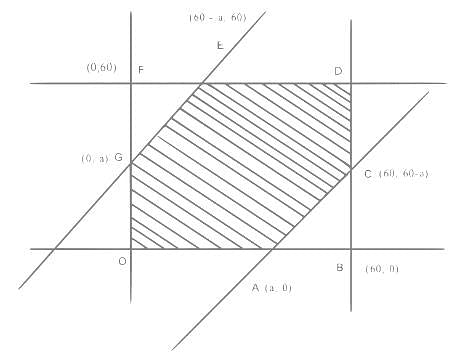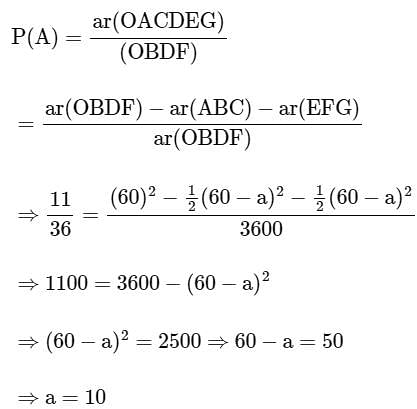JEE Exam > JEE Questions > Let A be the event that the absolute differen...
Start Learning for Free
Let A be the event that the absolute difference between two randomly choosen real numbers in the sample space [0, 60] is less than or equal to a. If P(A) = 11/36, then a is equal to _______.
Correct answer is '10'. Can you explain this answer?
Verified Answer
Let A be the event that the absolute difference between two randomly c...



Most Upvoted Answer
Let A be the event that the absolute difference between two randomly c...
Given:
- The sample space is [0, 60], which means the randomly chosen real numbers can range from 0 to 60.
- The event A is defined as the absolute difference between two randomly chosen real numbers being less than or equal to a.
- The probability of event A, P(A), is 11/36.
To Find:
The value of a, the absolute difference between the two randomly chosen real numbers.
Approach:
To solve this problem, we can use the concept of probability and the properties of the sample space.
Explanation:
We know that the sample space is [0, 60], which means that any real number between 0 and 60 (inclusive) can be chosen.
Let's consider the maximum possible difference between two numbers in the sample space. The maximum difference occurs when one number is 0 and the other number is 60. In this case, the absolute difference is 60.
Therefore, a must be equal to or less than 60 for the event A to occur. This gives us an upper bound for a.
Next, let's consider the minimum possible difference between two numbers in the sample space. The minimum difference occurs when both numbers are the same. In this case, the absolute difference is 0.
Therefore, a must be greater than or equal to 0 for the event A to occur. This gives us a lower bound for a.
Based on the given probability, P(A) = 11/36, we can conclude that the range of a lies between 0 and 60, inclusive.
We can now narrow down the possible values of a by considering the given probability. The probability of event A occurring is 11/36.
Let's assume that the first number chosen is x. The probability of choosing a second number such that the absolute difference between them is less than or equal to a is 11/36.
To find the value of a, we need to consider all possible values for x and see which ones satisfy the given probability.
If x = 0, then the second number must be in the range [0, a] for the absolute difference to be less than or equal to a.
If x = 60, then the second number must be in the range [60 - a, 60] for the absolute difference to be less than or equal to a.
For any other value of x, the second number must be in the range [x - a, x + a] for the absolute difference to be less than or equal to a.
Now, we need to find the values of x for which the second number falls in the required range.
Range of x:
- If x = 0, the range of the second number is [0, a].
- If x = 60, the range of the second number is [60 - a, 60].
- For any other value of x, the range of the second number is [x - a, x + a].
Calculating Probability:
We can calculate the probabilities for each case and sum them up to find the overall probability.
Case 1: x = 0
The probability of the second number falling in the range [0, a] is (a - 0) / 60 = a / 60.
Case 2: x = 60
The
- The sample space is [0, 60], which means the randomly chosen real numbers can range from 0 to 60.
- The event A is defined as the absolute difference between two randomly chosen real numbers being less than or equal to a.
- The probability of event A, P(A), is 11/36.
To Find:
The value of a, the absolute difference between the two randomly chosen real numbers.
Approach:
To solve this problem, we can use the concept of probability and the properties of the sample space.
Explanation:
We know that the sample space is [0, 60], which means that any real number between 0 and 60 (inclusive) can be chosen.
Let's consider the maximum possible difference between two numbers in the sample space. The maximum difference occurs when one number is 0 and the other number is 60. In this case, the absolute difference is 60.
Therefore, a must be equal to or less than 60 for the event A to occur. This gives us an upper bound for a.
Next, let's consider the minimum possible difference between two numbers in the sample space. The minimum difference occurs when both numbers are the same. In this case, the absolute difference is 0.
Therefore, a must be greater than or equal to 0 for the event A to occur. This gives us a lower bound for a.
Based on the given probability, P(A) = 11/36, we can conclude that the range of a lies between 0 and 60, inclusive.
We can now narrow down the possible values of a by considering the given probability. The probability of event A occurring is 11/36.
Let's assume that the first number chosen is x. The probability of choosing a second number such that the absolute difference between them is less than or equal to a is 11/36.
To find the value of a, we need to consider all possible values for x and see which ones satisfy the given probability.
If x = 0, then the second number must be in the range [0, a] for the absolute difference to be less than or equal to a.
If x = 60, then the second number must be in the range [60 - a, 60] for the absolute difference to be less than or equal to a.
For any other value of x, the second number must be in the range [x - a, x + a] for the absolute difference to be less than or equal to a.
Now, we need to find the values of x for which the second number falls in the required range.
Range of x:
- If x = 0, the range of the second number is [0, a].
- If x = 60, the range of the second number is [60 - a, 60].
- For any other value of x, the range of the second number is [x - a, x + a].
Calculating Probability:
We can calculate the probabilities for each case and sum them up to find the overall probability.
Case 1: x = 0
The probability of the second number falling in the range [0, a] is (a - 0) / 60 = a / 60.
Case 2: x = 60
The

|
Explore Courses for JEE exam
|

|
Similar JEE Doubts
Let A be the event that the absolute difference between two randomly choosen real numbers in the sample space [0, 60]is less than or equal to a. If P(A) = 11/36,then a is equal to _______. Correct answer is '10'. Can you explain this answer?
Question Description
Let A be the event that the absolute difference between two randomly choosen real numbers in the sample space [0, 60]is less than or equal to a. If P(A) = 11/36,then a is equal to _______. Correct answer is '10'. Can you explain this answer? for JEE 2025 is part of JEE preparation. The Question and answers have been prepared according to the JEE exam syllabus. Information about Let A be the event that the absolute difference between two randomly choosen real numbers in the sample space [0, 60]is less than or equal to a. If P(A) = 11/36,then a is equal to _______. Correct answer is '10'. Can you explain this answer? covers all topics & solutions for JEE 2025 Exam. Find important definitions, questions, meanings, examples, exercises and tests below for Let A be the event that the absolute difference between two randomly choosen real numbers in the sample space [0, 60]is less than or equal to a. If P(A) = 11/36,then a is equal to _______. Correct answer is '10'. Can you explain this answer?.
Let A be the event that the absolute difference between two randomly choosen real numbers in the sample space [0, 60]is less than or equal to a. If P(A) = 11/36,then a is equal to _______. Correct answer is '10'. Can you explain this answer? for JEE 2025 is part of JEE preparation. The Question and answers have been prepared according to the JEE exam syllabus. Information about Let A be the event that the absolute difference between two randomly choosen real numbers in the sample space [0, 60]is less than or equal to a. If P(A) = 11/36,then a is equal to _______. Correct answer is '10'. Can you explain this answer? covers all topics & solutions for JEE 2025 Exam. Find important definitions, questions, meanings, examples, exercises and tests below for Let A be the event that the absolute difference between two randomly choosen real numbers in the sample space [0, 60]is less than or equal to a. If P(A) = 11/36,then a is equal to _______. Correct answer is '10'. Can you explain this answer?.
Solutions for Let A be the event that the absolute difference between two randomly choosen real numbers in the sample space [0, 60]is less than or equal to a. If P(A) = 11/36,then a is equal to _______. Correct answer is '10'. Can you explain this answer? in English & in Hindi are available as part of our courses for JEE.
Download more important topics, notes, lectures and mock test series for JEE Exam by signing up for free.
Here you can find the meaning of Let A be the event that the absolute difference between two randomly choosen real numbers in the sample space [0, 60]is less than or equal to a. If P(A) = 11/36,then a is equal to _______. Correct answer is '10'. Can you explain this answer? defined & explained in the simplest way possible. Besides giving the explanation of
Let A be the event that the absolute difference between two randomly choosen real numbers in the sample space [0, 60]is less than or equal to a. If P(A) = 11/36,then a is equal to _______. Correct answer is '10'. Can you explain this answer?, a detailed solution for Let A be the event that the absolute difference between two randomly choosen real numbers in the sample space [0, 60]is less than or equal to a. If P(A) = 11/36,then a is equal to _______. Correct answer is '10'. Can you explain this answer? has been provided alongside types of Let A be the event that the absolute difference between two randomly choosen real numbers in the sample space [0, 60]is less than or equal to a. If P(A) = 11/36,then a is equal to _______. Correct answer is '10'. Can you explain this answer? theory, EduRev gives you an
ample number of questions to practice Let A be the event that the absolute difference between two randomly choosen real numbers in the sample space [0, 60]is less than or equal to a. If P(A) = 11/36,then a is equal to _______. Correct answer is '10'. Can you explain this answer? tests, examples and also practice JEE tests.

|
Explore Courses for JEE exam
|

|
Signup for Free!
Signup to see your scores go up within 7 days! Learn & Practice with 1000+ FREE Notes, Videos & Tests.


























